�@�@�@�@�@�@�@�@�@ THE ROLE OF JAPAN IN THE ASIA PACIFIC AREA.
�@
1. An Overview of AsiaPacific Area
Definition of Asia Pacific Area
�@I define the Asia pacific Area as APEC
(Asia Pacific Economic Cooperation) countries
plus China. APEC consists of ASEAN (Association
of Southeast Asian Nations) countries, U.S.
(United States of America), Canada, Australia,
New Zealand, South Korea, Japan, Taiwan,
Mexico, Papua New Guinea, and Chile. APEC
was established with the aim of fostering
continuous development in the Asia Pacific
Area and presenting an open regional cooperation
model. The first conference at a ministerial
level was held in Canberra in November 1989.
Geographically, this area incldes Russia (far east), North Korea, Mongolia, Vietnam, Cambodia, Laos and Myanmar. In this paper, I will mainly discuss the economic role of Japan .It is very difficult to obtain reliable statistics on these countries and the economic weight of these countries seems to be small;therefore, I have elected to exclude these countries from the definition of Asia Pacific area.
�@
�@
The Asia Pacific Area in the World
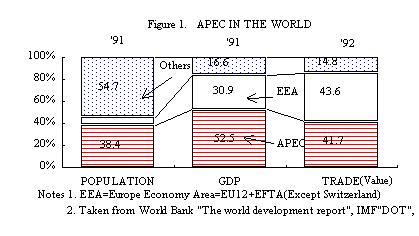
Countries in the Asia Pacific Area accout
for 38.4% of population, 52.5% of GDP, and
41.7% of international trade in the world
in 1991 or 1992. (Figure 1.)
The amount value of intraregional trade
of this area is more than that of EU (Europe
Union), which completed market integration
in 1994. (Figure 2.)
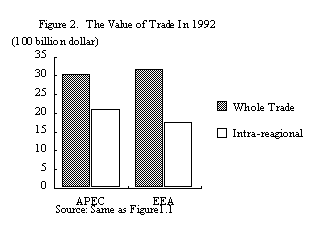
�@
�@
�@
�@
�@Taking into account GDP and Population,
the area can be called an active economic
area. On the other hand, international trade
can be termed relatively small compared to
the scale of its economy. This mainly resuilts
from the trade of EEA (Europe Economy Area)
being big. EEA is in the Europe Continent
and there is no physical barrier like the
sea between menmbers, so trade between menmbers
may be relatively easy. Moreover, the existence
of a free market treaty is thought to promote
the trade in the EEA. In fact, the ratio
of EU's intraregional trade to the world
trade is nearly 25 percent, in spite of its
population accounting for only a small percent.
�@Now, looking at economic activity in the
Asia Pacific Area by country, the per capita
national inc
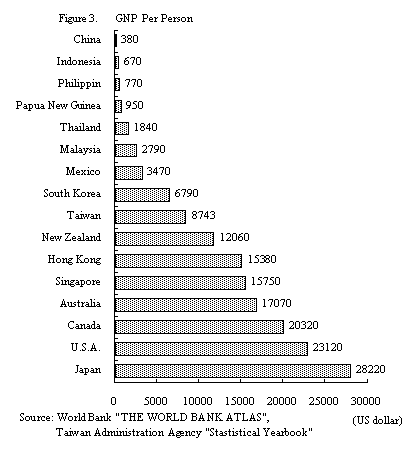
omes in the area is very different, from
28,220 US dollars in Japan to 370 US dollars
in China. (Figure3.)
And manufacturing factors such as labor,
natural resources, technology etc. shows
great diversity in this area. This diversity
in this area seems to lead to mutual dependance
in the economic development of those countries.
For example, a corporation which plans to
produce manufacturing goods in this area
can use the cheap labor of china, the high
technology of U.S. and Japan, and the relatively
cheap and high quality parts from NIEs. The
products made in this area can be competitive.
That is, the more active the economy of this
area becomes, the more interdependent countries
in this area tend to be.
�@
�@
�@
�@
�@
�@
�@
�@
Trade Structure
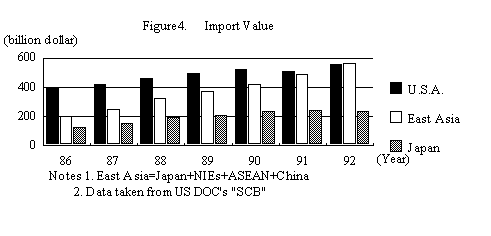 As I mentioned above, the Asian Pacific
Area's weight of international trade (export+import)
in the world is about 40%. Among them, intraregional
trade accounted for about 70%. (1992)
As I mentioned above, the Asian Pacific
Area's weight of international trade (export+import)
in the world is about 40%. Among them, intraregional
trade accounted for about 70%. (1992)
When we compare the value of imports, divided into east Asia, Japan and U.S., we can see the weight of east Asian imports rises. (Figur 4.)
This is considered to be because
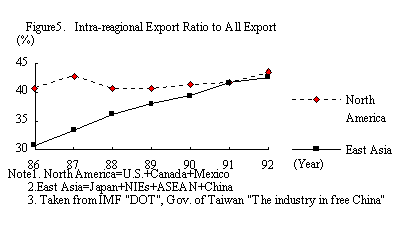
Japan and NIEs increased their foreign investment
in East Asia. Such investment expanded the
intraregional trade of parts and manufacturing
equipment. In fact, the intraregional
export ratio to all export of East Asia rose
from 30.7% in 1986 to 42.6% in 1992. This
is in striking contrast to the experience
of North America. (Figure 5.)
This export trend also means that recent East Asian countries more strongly depended on each other in rapid speed.
Investigating the other area's inter and intraregional trade will make clear Asia's present position in the world and its fluctuation over time.
�@
When we look at Table 1., the economic data reveal distinctive patterns in trade across the three regions of Asia, Europe, and North America.
�@The table shows that intraregional trade has risen in all three regions in recent thirty years. Between 1958 and 1989, intraregional trade increased by 25 per cent for North America and Asia, while that of EC. grew by almost 100 per cent over the same period. It accounted for virtually twothirds of all EC. trade.
But the largest increases in trade flows over these thirty years are in North American and EC. trade with Asia. Taking into account the extent of trade between Asia and North America, the importance of Asia as a trade partner emerges as being more meaningful for North America than for Europe.
For Asia, trade with North America and EC. grew more rapidly than intraregional trade.�@The same is true of intra and interregional trade of North America.
These figures suggest that trade flows between these two regions are healthy and growing. And they are more interdependent ,as in the Asian Pacific Area.
This does not seem to be the case for the EC. Here, intraregional trade dominates interregional trade. The EC. is becoming relatively more exclusive than the other area.
�@ Table 1.�@�@�@�@ Inter and IntraRegional Trade
�@ |
�@1958�@�@�@�@�@ 1989�@�@�@�@�@ Change |
North America
IntraNA / Total NA
NA to EC / Total NA
NA to Asia / Total NA
EC Trade
IntraEC / Total EC
EC to NA / Total EC
EC to Asia / Total EC
Asian Trade
IntraAsia / Total Asia
Asia to NA / Total Asia
Asia to EC / Total Asia
�@ |
�@28%�@�@�@�@�@�@ 35%�@�@�@�@�@�@25%
�@11�@�@�@�@�@�@�@18�@�@�@�@�@�@ 64
�@10�@�@�@�@�@�@�@29�@�@�@�@�@�@190
�@30�@�@�@�@�@�@�@58�@�@�@�@�@�@ 93
�@12�@�@�@�@�@�@�@ 9�@�@�@�@�@�@25
�@ 3�@�@�@�@�@�@�@ 7�@�@�@�@�@�@133
�@34�@�@�@�@�@�@�@42�@�@�@�@�@�@ 24
�@19�@�@�@�@�@�@�@30�@�@�@�@�@�@ 58
�@10�@�@�@�@�@�@�@15�@�@�@�@�@�@ 50
�@ |
NA is North America, including Canada, Mexico, and U.S.
EC is six European community states in 1958; 12 in 1989.
Asia is India, ASEAN, Japan, Northeast Asia.
Source: IMF, Direction of Trade.
�@
APEC (Asia Pacific Economic Cooperation)
APEC is considered to be one of the key organizations in this area. Thus, we review recent APEC activity.
The fifth APEC conference at a ministerial level was held in November 1993. In the conference, liberalization of international trade and investment became the main issue. U.S. proposed the notion of a "Pacific Community" and regarded the Asia Pacific Area as a market which should reduce its impediments to trade and investment.
Meanwhile, many Asian countries expressed their anxiety about economic confusion caused by rapid liberalization and formulation.
Finally, each country agreed to promote international trade and investment by rearrangement of "Regional Trade Liberalization informal Meeting" to "International Trade and Investment Committee" in the communique as to Trade and Investment Framework.
The committee is going to deal with continuous problems such as custom procedures, foreign investment and standard & certification. Still more, it will deal with the "Sage Meeting" report and foreign investment of small and mediumsized enterprises.
At the same time, the informal economic summit of APEC was held. Most of the important leaders of this area got together and exchanged opinions for the first time. At the summit, they adopted the documents on the prospects of APEC and visions such as educational programs, business volunteer programs, establishment of APEC foreign minister meeting and so on.
�@
�@APEC is very different from other regional organizations such as EU and NAFTA, as APEC countries don't aim at market integration, and even its permanent office was established recently. APEC seems to be just a place to exchange member countries' opinions and to encourage cooperation.
Asian countries and U.S. often contrast in their views as above. The U.S. is now concerned about its huge trade deficit and wants to open other countries' markets as a free market. However, most Asian countries are developing nations, they believe the development of U.S. and other advanced countries were accomplished by the victim of developing countries as a "colony". Therefore, U.S. and other advanced countries condeming these countries' market closeness disgust most Asian countries. Moreover, to these nations, the U.S. attitude seems one of mere pursuit unilateral advantage and without thought for development in these aera. That is, the confrontation partly arises out of feelings. While the markets of Asian countries are admittedly somewhat closed as the U.S. points out. However, these impediments should be removed over time, since the area is inherently be more interdependent and such condition should be protected. Then APEC has a possibility of being one of the most important organizations in the world because of the extent of its impact on the world economy (Cf. Asia Pacific Area in the World, Figure 1.1). This area is now growing most rapidly in the world. If the member countries' policies were affected by the decisions or the agreements of APEC, they would have big influence.
�@
Japan's Position in This Area
As of 1992, Japan's GDP accounted for 29.5%
in the Asia Pacific Area, despite�@a population
which accounted for only 5.9% at the time.
That is, Japan has a big influence as an
economic power in this area, now. Even if
we think about future figures of GDP by country
, Japan may not lose its relative economic
power in this area.

We made a trial calculation, assuming that over the recent fiveyears' (19891993) real GDP growth continues. In this trial calculation, we assumed the Asia Pacific Area to comprise U.S. and Asia, and Asia, Japan, NIEs, ASEAN and China. (Note 1. This assumption differs from that of other tables and figures; therefore, the number used here does not coincide with the other information. Note 2. Because Japan's big boom, the�@so called "bubble economy period", is contained in this calculation, the figures on Japan's GDP in the future may be somewhat over.)
According to this calculation, Japan's percentage of GDP will level off either twenty years later or thirty years later in spite of the other Asian countries' rapid GDP growth. Taking 2021 (30 years later) for instance, Japan's GDP will account for 35.6% in the Asia Pacific Area. This is because the U.S. weight will have relatively declined. Therefore, Japan's GDP weight in Asia will decline drastically (Table 2.2).
Meanwhile, Japanese society is now rapidly aging. According to the Japanese government survey (population statistics) as of 1990, people 65 years old or over accounted for nearly 12 percent of the total population. The percentage is the highest on record since 1920 when the survey began. Meanwhile, boys and girls under 14 account for less than 19 percent, a record low. If this trend continues, the number of people 65 years old or over will be more than that of people under 14 by the end of this century. Then the government of Japan will have to spend considerable sums of money on pensions to those people and may have to change the pension system.
There is a strong possibility that Japan will become an excess investment country in the near future because savings in Japan will decrease due to huge pension expenditure by the government and a decline in the savings rate by households.
�@
Next we look at Japan's trade. Japan's international trade accounted for 18.8% in the Asia Pacific Area, and 7.9% in the world in 1992. The weight of U.S. international trade is admittedly bigger; however, Japan's trade ratio to whole trade can also be called big enough.
Between 1958 and 1989, the trade flow betwen Japan and the other Asian nations for Japan�@leveled off. However, the percentage of trade of other Asian countries with Japan has grown faster, and almost equqled the percentage of trade with North America. In other words, Japan has become a more important trade partner for other Asian countries compared to thirty years ago.
�@
�@ Table 3.�@�@�@�@�@�@�@�@Asian Trade Flows
�@ |
�@ 1958�@�@ 1989�@�@Change |
Japan to Other Asia/Total Japan
Japan to NA/Total Japan
Japan to EC/Total Japan
Other Asia to Japan/Total Other Asia
Other Asia to NA/Total Other Asia
Other Asia to EC/Total Other Asia
IntraOther Asia/Total Other Asia
�@ |
�@�@27%�@�@�@30%�@�@�@ 11%
�@�@33�@�@�@ 33�@�@�@�@ 0
�@�@ 5�@�@�@ 16�@�@�@ 220
�@�@ 8�@�@�@ 19�@�@�@ 138
�@�@13�@�@�@ 20�@�@�@�@54
�@�@10�@�@�@ 13�@�@�@�@30
�@�@27�@�@�@ 30�@�@�@�@11
�@ |
SOURCE: IMF, Direction of Trade.
�@
Certainly, one of Japan's biggest problems in international trade is her trade surplus. Japan's trade surplus ballooned to US$ 82.7 billion in 1986 but subsequently contracted against the background of the yen's appreciation. However, in 1991, it began to grow again. As a result of a first decrease in imports in six years consequent to the economic recession, the trade surplus in 1992 topped the US$ 100 billionmark for the first time in history.
Although describing the amount of trade surplus between two countries is somewhat misleading (sometimes, one country's trade surplus with that of another country surpasses her trade surplus. ), forty percent of Japan's surplus came from trade with United States. Trade surplus with EU and with Asia were the biggest ever in 1992.
�@The meaning of trade surplus in economics is discussed in the next chapter. Now, we focus on the structure of Japan's exports and imports.
Japan's main exports are machinery and equipment including automobiles and electrical and electronic products. These items accounted for 76% of all exports in 1992. Considering that textiles and textile goods were the biggest and accounted for 30% of total exports, those exports of today�@(accounting for only 3% of total exports) are almost ignored. Meanwhile now miscellaneous goods, then 20% of total exports, and iron and steel and metal goods, then 14%, have declined from the 1960 figures by about half.
Next, we look at imports to Japan. The ratio of imports of raw materials and fuel, including mineral fuels such as crude oil, the textile raw material and metal raw material, to total value of imports, was 34% in 1992. Considering that raw materials and fuel
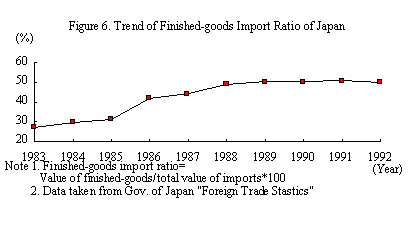
accounted for 66% of total imports in 1960, this is a large drop.
Conversely, finishedgoods imports of machinery and equipment and textile goods are increasing.
The ratio of finished goods imports to total imports exceeded 50% in 1989 (Figure 6.).
This is because imports of machinery from Europe and U.S., and that of the home electric appliances and textile goods from Asia is also increasing.
However, the finishedgoods import ratio of Europe and U.S.(7580%) is higher than that of Japan. And this is the one of the reasons why Japan is often criticized for having a closed market.
�@
2. An Itemized Discussion
Driving force for Asian Development
To analyze the Asian Pacific Area more specifically,
the area should be divided into two parts,
Asia and other areas. Because Asian countries
have grown and are expected to grow more
rapidly than others.
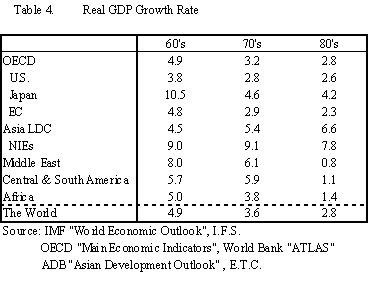
In 1979, OECD identified 10 countries, which included Asian, European and South American countries, as NICS (Newly Industrialized Countries). But only Asian NICS grew constantly over the past decade.
What was different about these countries? Now, it is useful to consider the reason only Asian countries grew so rapidly after world war �U.
(Note. Asia NICs are now called NIEs, because Taiwan and Hong Kong, which are not always recognized as sovereignty countries, are included.)
�@
Generally speaking, there seem to be six reasons which promoted development in Asian countries.
�@U.S. absorption and her aid to Asia were very big.
�AJapan's ODA and investment to Asia contributed to their development.
�BThose countries have an effective and able bureaucracy which is based on Confucianism, a practical religion.
�CMost countries in Asia could get assistance from multilateral institutions such as the IMF(International Monetary Fund), UN(the United Nations) and World Bank in the early period after World War �U, because they were classified to victorious countries in the war and could join these organizations with hindrance.
�DAround 1970, many Asian countries could catch the first postwar wave of industrialization, because they had desirable industries such as textiles,or food processing by then.
�EIn the first half of the 80's, many Asian countries had a huge cumulative debt. But they could cope well with their adjustment policy.
�@
Some of these like �@,�C,�D are common factors for all or some developing countries. With regards to �E, other similar countries which had a huge cumulative debt also adopted almost the same policy, so this factor is nothing special for Asian countries.
Now, �A & �B are considered to be special factors for Asian countries' development.
The main factor in rapid economic growth may be appropriate introduction of foreign technology and investment. Furthermore, an effective and able bureaucracy may be esential for developing countries to catch up industrialized countries. If their theory is correct, we can understand why only Asian countries could grow so rapidly.
Thus, in the case of Asia, they have an appropriate social system for growth, and U.S., and Japan transferred technology and capital to them through foreign investment and ODA.
�@
Japan's Official Development Assistance
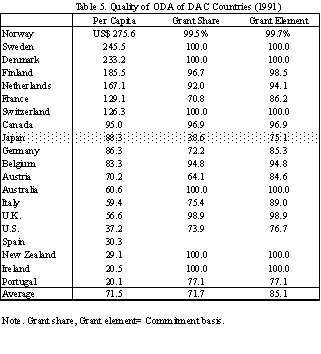
�@Japan's international contribution consists
mainly of official development assistance
(ODA). The total amount of Japan's ODA in
1992 was 3.7 times that of 10 years ago.
It was the biggest among the 21 member countries
of the Development Assistance Committee (DAC),
a subsidiary organization of OECD.
But, Japan's ODA is sometimes criticized because its quality is inferior. In fact, the ratio of loans is very large, and the number of Japanese officials engaged in assistance work is small.
�@
The quality of ODA is usually expressed by the grant share and grant element(GE).
(The grant share represents the ratio of grants (grant assistance, technical assistance and contribution to multilateral institutions) in the total amount of ODA. On the other hand, GE represents terms of assistance, such as interest rates and repayment periods. The milder the terms, the higher the GE. For instance, the GE of grant assistance is 100%.)
According to these criteria, Japan's grant share is the lowest amoung the DAC countries (38.6%, average 71.7%, 1991). And Japan's Grant Element is also lowest(75.1%, average85.1%, 1991).
It is true that the amount of Japan's grant assistance has been increasing yearly, but its ratio in the ODA hardly changes. This seems to be because Japan is increasing her grant assistance in order to maintain the quality of its assistance.
�@
However, smallness of grant assistance doesn't always mean inferiority, for low interest loans provide the oportunities for " middle developing countries" learning how business goes. In the other words, it encourages the independence. For example, grant assistance for projects such as constructing roads and filtration plants finish if these are completed. In some�@cases, moreover, advanced countries have to provide aid to maintain such facilities. This seems somewhat ineffective.
On the other hand, in the case of low interest loans, because a creditor nation has to collect debts and a debtor nation has to pay, both sides have to make an effort to transfer�@skills for earning money using facilities�@made by aid such as transportation systems like bus or rail road, electricity plants and toll roads. That is, in such cases, business knowhow can be said to be transferred to developing countries more early than grant assistance.
What many South East Asian countries, which are assisted by Japan, took off from LLDC may prove this point of view.
�@
Foreign Investment Change the Figure of International Trade
Japan's Foreign direct investments, such
as the building of factories overseas, increased
rapidly from around 1972. First advances
were into Asia to seek cheap labor because
of the yen's application. From around 1981,
investments were made in U.S. and Europe
with a view to easing trade friction. Investment
in advanced nations expanded rapidly after
the yen's sharp rise beginning in the fall
of 1985. But after 1990, foreign direct investment
from Japan began to decline due to the business
recession. Some companies even withdrew.

We can look at the trends based on regions and industries more specifically using the Ministry of Finance's "Report on Results of Direct Investment in Foreign Countries"(since it is based upon reports, its peak is 1989). According to the report, by region, except for towards Asia, it has been decreasing since 1990. Especially, towards North America, in 1992, it dropped more than 40% of 1989. In type of industries, the investment both in manufacturing industries and nonmanufacturing industries decreased. Especially, nonmanufacturing industries like real estate, financial and insurance was large.
The following points can be pointed out as reasons for such declines in foreign direct investment.
First, it is a fact that the big investment towards U.S. and Europe in main industries had almost made their rounds.
Second, it is fact that the drop in the profit rate in local subsidiaries stands out. While the economy in Europe and U.S. has stagnated, the current profit rate of local subsidiaries ,which had been originally at a low standard, dropped even more.
Third, is that while business results of parents companies in Japan are aggravating, the capital costs have increased and the capital supply strength has wakened.
Though recent Japanese foreign direct investment is declining as described above, Japanese accumulated foreign direct investment is already considered to be very huge. And that of the world is very huge as well. These investments are changing the structure of world trade.
Once upon a time, "a nation in economics" was defined as the area in which manufacturing factors such as capital, labor and technology could not be transferred freely. At that time, trade meant only buying and selling goods. But in recent years, foreign direct investment is changing the world trade structure through increasing transfers beyond the border of manufacturing factors as above.
For example, an increase of manufacturing overseas leads to expantion of technology trade and trade inside enterprises. It promotes industrialization of the countries that accepted foreign direct investment from advanced countries, and also has finished goods trade increased.
In the long run, foreign direct investment can be said to contribute to the growth of these countries. Especially, Japan's investment played a big role because of its weight in this area.
�@
Appreciation of the Yen
As set out above, Yen's apprciation impacts
on Japan's foreign direct investment. It
is often said that a huge trade surplus causes
it. Now, I review the recent movement of
the Yen's exchange rate and consider its
meaning in economics.

Since February 1993, the Japanese yen has continuously appreciated against the US dollar and has topped the 100 yen marks since the summer 1994. Here, we discuss the background of the fluctuation in the rate and its influence.
There has been a surge in the yen rate since 1993. Comparing the phase of the strong yen in 1993 and 1994 to that of the past, at in view of the rate of the increase, the recent yen surge is not remarkable in scale. For example, the phase of the strong yen that lasted from February 1985 through early January 1988, with the Plaza Accord between, recorded a rate of increase as high as 104.0%. Besides this period, the Japanese economy has, in the past, repeatedly experienced a phase of a strong yen of a greater magnitude.
In view of the effective exchange rate, which also takes into account the exchange rates of the currencies of other countries besides the U.S., basically the same trend as the YenUS dollar rate can be seen. This means that the yen is getting stronger against other currencies as well as dollar. (If the strong yen against the US dollar was the result of the US dollar's weakness against other currencies, the effective exchange rate would not change as much as the yen dollar rate.)
�@Various factors affect the yen rate. Among them, the purchasing power parity doctrine as a long term factor, the current balance and interest differential as a short term factor will be focused on.
First, we discuss the purchasing power parity doctrine. "The law of one price" is one of the most basic principals of economics. If this principle was applied to the international economy, the exchange rate would be adjusted to make the prices of goods that are traded internationally equal. This is the thought of this doctrine. In practice, however, incomplete competition, continuous trade relations and such exist; it is thought that this type of arbitration between trade goods is applied in the long run.
In fact, the actual yen rate roughly parallels the movement of purchasing power parity on domestic wholesale prices. The movement of purchasing power parity on domestic wholesale prices is thought to reflect the stable rate of price growth in Japan, its high rate of productivity growth compared to that of other countries and so on. That is, the future movement of Japanese prices and productivity growth will determine the future yen's exchange rate.
Next, comparing the movements of the current account and the yen rate, a fairly high correlation can be seen. However, the reason why they correlate is not evident. The exchange rate is determined by the relationship between demand and supply for monetary assets quoted in foreign currencies. When the transfer of capital is limited, as was the case in the 1970's, the flow of the current balance naturally affects the exchange rate because it corresponds to the sum of increase or decrease in external assets.
However, when the transfer of capital has been liberalized, as is the case today, the entire external assets become the object of arbitration, and fluctuation of the yen's rate cannot be explained by the flow of the current account. This can be understood by the fact that the amount dealt in the foreign exchange market in recent years has become about 60 times as large as the flow of trade value (1992) in Japan. Under such circumstances, it is appropriate to approach that relation from the stock phase, taking into account the total amount of external assets.
The relationship between the current balance and the exchange rate can be explained by observing that the accumulated current account surplus equals the stock of external assets. First, if the current balance surplus continues to increase, the net external assets will also increase in the same amount as the increase in the surplus. In cases where this is foreign currency denominate, there is always exchange risk. Thus domestic investors would not want to hold it unless there were some premiums that compensate for the risk. Therefore, the present exchange rate is expected to increase as high as the risk premium and a future foreign currencies' appreciation must be expected. Through this route, the flow of current account surplus works as a pressure for a stronger yen.
The interest difference between countries influences the yen rate through capital transfer of overseas security investment and the like. Until the interest differential and the future estimated exchange rates' exchange ratio become roughly equal, through capital transfer, arbitration between financial assets will occur. For example, if the interest rate in the U.S. increases, the present yen would fall until the future rate of the yen's increase reaches the level that compensates for it. From 1981 to 1985, the yen Weakened amid the current balance surplus expansion, and this was because the rise of the interest rate in U.S. expanded the differential in real interest rate, and activated overseas security investment in Japan.
In the long run, the yen's exchange rate will be determined by how Japanese prices go, how her productivity will goes, and how the current account surplus is. Of course, the current account balance is heavily dependent on the trade balance or the international trade structure.
�@
Meaning of Trade Imbalance & Trade Surplus
�@As previously pointed out, Japan's trade
surplus and her current account surplus are�@huge.
Now we discuss them.
The recent expansion of the current account surplus seems to come from such factors as follows. The first is the short term influence of such temporary factors as the temporary jump in crude oil prices due to the Gulf War and the gold investment due to the issuing of�@the memorial coin in 1991 and 1992.
The second is the influence of export price increases due to the yen appreciation. The third is the influence of the collapse of "the bubble economy." This collapse reduced imports such as luxury goods, for example luxury cars, jewelry, pictures and so on. The forth is the fact that the Japanese economy was in an adjustment process until the summer of 1994.
As mentioned above, the recent expansion of current account surplus can basically be explained fully by cyclical factor, temporary factor, and the exchange rate factor.
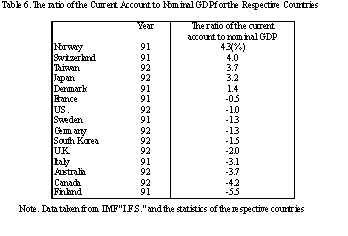
However, when we discuss the causes of the current account surplus, it is important to distinguish between the factors that cannot be explained and the factors that can.
An argument which can be seen often is that "current account surplus expanded because of the closed market." This is an argument to try to explain the current surplus from a micro aspect. However, it is impossible to explain the current account only with market exclusiveness. This point can easily be verified by the time series data as well as the respective country data as to the ratio of current account to nominal GDP. From the time series point of view, current account surplus fluctuated violently and we can't establish regularity. Even with the respective country data, it cannot necessarily be said that the higher the ratio of current account surplus the countries have, the more closed their market is.
Next, how should we appraise Japan's current account surplus? We confirm the economic implications of it.
Japan's current account surplus has three aspects. They are, �@the aspect of Japan being a net supplier of tradeable goods, �Athe aspect of Japan being an excess savings nation and �Bthe aspect of Japan being a capitalsupplying nation.
�@
We can consider what the first aspect means by taking up exports and imports in turn.
Japan's exports have changed the supply structure flexiblely and efficiently, by means of sensitively catching such change on the demand side as tastes and needs of consumers. Employing the scale merit to the greatest limit, Japan has managed to specialize in growth products at the same time. Now, Japan is the greatest supplier of intermediate and capital goods such as machinery. It can be said that Japan is contributing to the improvement of the growth capacity of the world.
On the other hand, from the import side, Japan is the largest net importer with regards to food. In recent years, both intermediate and capital goods imports have expanded, and for ASEAN, Japan has become the greatest importer.
If the transactions are respectively carried out as results of rational transactions in a free market, it will mean that both exporter and importer receive desired results through trade. Under these conditions, Japan is contributing to the expansion of world trade both in imports and exports. It can be said that Japan is improving the economic welfare of the entire world through trade gains. However, if distortions exist in exports and imports, such conclusion cannot be drawn up.
�@
The second aspect of Japan's current account surplus is that of Japan being an excessive savings nation.
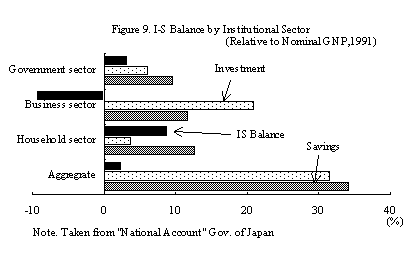
The current account balance is equal to the difference between domestic savings and investment. As for Japan's savingsinvestment balance after the 1980's, although the net savings of the household sector has remained at about the same level, the net investment of the government sector declined in the early 1980's. In the latter half of the 1980's, the general government sector became a net saving sector, and the balance widened, but the corporate sector's net investment expanded in excess of that.�@The expansion of net savings of the government sector was brought about by the reduction in net investment of the central government due to fiscal consolidation and increase of taxes due to the economic expansion as well as by the further increase in the net savings of the social security funds, etc.
Also, the expansion of corporate sector investment followed from the economic expansion. But after 1991, the amount of investment by the corporate sector declined, because of a fall in equipment investment due to the economic recession. These movements basically match the movements of the current account surplus.
After all, these movements in savings and investment are basically the result of the actions of respective economic bodies responding to changes in the economic environment, and as long as there is no institutional bias, it cannot be said to be a problem. Especially, Japan expects to decline in saving ratio due to the aging of the population in the near future, and it can be said that Japan is now in the stage in which it is necessary to increase savings. Positive net savings means that assets are accumulated as external assets.
�@
The third is the aspect of Japan being a capitalsupplying nation. This is because Japan's net savings is supplied overseas as capital export.
Capital export plays an important role in relaxing the constraint on equipment investment due to the availability of domestic savings. The constraint on equipment investment due to the availability of domestic savings becomes strongest when capital transfer is limited. However, as the liberalization of capital transfer progressed, constraints on domestic investment due to domestic savings weakened. Because the domestic demands on investment are sufficient by financing by foreign capital supply.
From this point of view, Japan's capital supply has fulfilled a large role in the promotion of global investment.
In particular, the foreign direct investment of Japan, which has rapidly increased since the latter half of the 1980's, has contributed greatly to the advancement of the world economy. When local production is set up by foreign direct investment, it will strengthen the host country's base of economic development by increasing local employment and transferring technology.
As mentioned above, it can be said that Japan's current account surplus doesn't have any problem in itself from the view of economics.
�@
Hollowing out of the Japanese Economy
�@We don't have clear definition of "the
hollow economy." It roughly means the
economic situation in which the manufacturing
industry loses its competitiveness, the leading
industry goes out from the country through
foreign direct investment, and the service
industry remains in the country. In conclusion,
the growth speed of the country begins to
drop.
If the industry hollows out, domestic production declines and an unemployment problem is aggravated.
It is said that the economy of the U.S. hollowed out in early 1980's due to the strong dollar and rapid domestic demand increase. At that time, the U.S.'s finished goods import ratio to all imports increased rapidly, and her trade deficit expanded simultaneously. Considering that her foreign direct investment in this period did not increase, it seems to be difficult to attribute the U.S. hollowing out to foreign direct investment (flow base). However, most of the increased finished goods imports having come from overseas subsidiaries of U.S. firms, accumulated foreign direct investment can be said to have caused the U.S. hollowing out.
In the case of Japan, after 1985, foreign direct investments increased very rapidly, because of the appreciation of the Yen. After March 1993, the Japanese Yen began to rise again. The yen may possibly boost Japan's foreign direct investment again.
. In any case, the accumulated Japanese foreign direct investment has already become very big. Now, most leading Japanese manufacturing companies have an option where to produce their products, inside Japan or overseas, depending on the Yen's exchange rate.
This fact may sugest a hollowing out of
the Japanese economy. On the other hand,
it implies expansion of the Japanese import
market for the other countries if some industries
healthily transfer to outside Japan, that
is, not reducing Japan's exports.
3. Conclusion
In conclusion, what is Japan's role, or what should Japan do to increase the social welfare of the AsiaPacific region, or to develop this area more? Politically, some people say, "I don't know what Japan's identity is."
This seems to be because Japan has not finished her compensation to countries and their residents for its damage.
Germany apologized for its conduct during WW�U, compensated victims, and now they are making efforts to contribute to international society. Japan would have to make more efforts other than being a permanent member of U.N. security council to be accepted in the true sense by the international society.
�@
Japan's Role in Economic Aspects
In this paper, we mainly considered Japan's
role in economic aspects. There seem to be
four main pillars that Japan should tackle.
First, Japan should open her market to the other countries, that is, Japan should increase its imports.
Increasing imports, especially finishedgoods imports, means that Japan provides a chance for development to other nations.�@It doesn't only imply that Japan can reduce its trade surplus. Therefore, Japan should not reduce her exports intentionally to reduce her trade surplus.
From this point of view, there are three policies that Japan can adopt.
�@Making use of savings, and expanding domestic demand.
The recent increase in the current account surplus can partly be attributed to the ongoing adjustment of the business climate. Japan should, for its own sake, endeavor to expand domestic demand in order to put the economy on a sustainable growth path.
�APromotion of structural policies and improvement of market access.
Promoting structural policies, which would enlarge the scope of the function of the market mechanism and enhance the efficiency of resource allocation, is important for Japan in sustaining her economic vitality. By this means, Japan can increase her imports. And if there is a case where a bias for or against exports or imports exists and where it is contributing to the additional surplus to the current account surplus, removing such biases would bring the current account surplus to an appropriate level.
�BMaintaining and strengthening the multilateral free trade system.
In recent years, the expanding foreign trade imbalance and the emerging protectionism have lead to movements such as bilateral agreements and, unilateral retaliatory measures that tend to deviate from the multilateral free trade system . Japan, a nation which fully recognizes the benefits of this system, and is fully aware of the merits, should actively contribute to the maintenance and development of this system.
�@
Second, Japan should format an efficient and effective capital recycling system.
In the latter half of the 1980's, Japan principally recycled the current account surplus in the form of a long term capital outflow. "Borrowing short term, and a lending long term". It has fulfilled a role of an international financial intermediary. This means Japan takes risks for the international economy, because long term capital is usually used to construct the infrastructures which contribute to the expansion of the economy.
�@
Third, Japan should reduce her current account surplus so that world countries would be acceptable. This can be partly carried out by deregulation such as structural policy and expanding domestic demands.
However, Japan is rapidly aging. So, in the near future, Japan could have huge current account deficit. Then, even if Japan would be a capital supplier, she may not have enough power to provide capital anymore. This change could be a cause of confusion in the world economy again.
So, now, Japan would be well advised to increase her investment as little as the level of savings so as not to have to increase her investment in the future.
�@
Finally, Japan should increase her technical assistance and development assistance.
Many countries in the Asia Pacific Area still need aid from industrialized countries to be independent economically. As we mentioned before, we believe the transfer of technology is one of the most important factors for developing countries expanding their economies and becoming independent.
It is a fact that foreign direct investments accompany the transfer of technology, and its role is big for some developing countries. Therefore the government of Japan should also make efforts to establish some circumstances in which the private companies can easily invest abroad.
In that case, to protect the environments of foreign countries, the government of Japan should adopt some policies that prevent the subsidiaries of Japanese enterprises from degrading the environment as many developing countries don't have enough restrictions to protect their environments.
�@
On the whole, Japan seems to carry out a positive role in the Asia Pacific Area, though she has some problems such as the current account surplus.
The Asia Pacific Area is unique, because this market, as APEC, doesn't employ any discrimination between intraregional trade and interregional trade unlike EU and NAFTA. And this area is now growing most rapidly in the world and is diversified in the fields of economy as well as culture, humanities. This is the reason why this area is becoming more interdependent.
We believe this area has great possibilities and can contribute to improvements in the world social welfare. We hope Japan carries out her role in this area and contributes to the world.
�@
�@�@�@�@�@�@�@�@�@�@�@�@�@ Suggested Readings
�@
Richard Stubbs and Geoffrey R.D. Underhill, Political Economy and the Changing Global Order. McClelland & Stewart Inc, 1994.
�@
Baldwin, Robert E., ed. Trade Policy Issues and Empirical Analysis. Chicago: The University of Chicago Press for National Bureau of Economic Research, 1988.
�@
White paper on international trade. Ministry of International Trade and Industry, Government of Japan.
�@
H.J.Aaron & C.L. Schultz "What Can Government Do?" Setting Domestic Priorities The Brooking Institution.
�@
Japan Development Bank, ed "Potential Growth Power of Japan" Nihon Keizai Shinbun Inc. 1994
�@
Asahi Shinbun, ed. Japan Almanac 1994, Asahi Shinbun Publishing Company. 1994
�@
Economic Planning Agency, ed. Economic Survey of Japan, Government of Japan.
�@
Economic Planning Agency, ed. White paper on World Economy, Government of Japan.
�@
Michael E. Porter, ed. Competition in Global Industries, Harvard Business School Press, U.S.A. 1986
�@
Kim B. Clark & Takahiro Fujimoto, Product Development Performance, Harvard Business School Press, U.S.A. 1991
�@
Institute of Economic Planning, ed. Economy Society Policy, Institute of Economic Planning. 1992
�@
E.T.C.
��TOP PAGE



 omes in the area is very different, from
28,220 US dollars in Japan to 370 US dollars
in China. (Figure3.)
omes in the area is very different, from
28,220 US dollars in Japan to 370 US dollars
in China. (Figure3.) As I mentioned above, the Asian Pacific
Area's weight of international trade (export+import)
in the world is about 40%. Among them, intraregional
trade accounted for about 70%. (1992)
As I mentioned above, the Asian Pacific
Area's weight of international trade (export+import)
in the world is about 40%. Among them, intraregional
trade accounted for about 70%. (1992)
 Japan and NIEs increased their foreign investment
in East Asia. Such investment expanded the
intraregional trade of parts and manufacturing
equipment. In fact, the intraregional
export ratio to all export of East Asia rose
from 30.7% in 1986 to 42.6% in 1992. This
is in striking contrast to the experience
of North America. (Figure 5.)
Japan and NIEs increased their foreign investment
in East Asia. Such investment expanded the
intraregional trade of parts and manufacturing
equipment. In fact, the intraregional
export ratio to all export of East Asia rose
from 30.7% in 1986 to 42.6% in 1992. This
is in striking contrast to the experience
of North America. (Figure 5.) We made a trial calculation, assuming that over the recent fiveyears' (19891993) real GDP growth continues. In this trial calculation, we assumed the Asia Pacific Area to comprise U.S. and Asia, and Asia, Japan, NIEs, ASEAN and China. (Note 1. This assumption differs from that of other tables and figures; therefore, the number used here does not coincide with the other information. Note 2. Because Japan's big boom, the�@so called "bubble economy period", is contained in this calculation, the figures on Japan's GDP in the future may be somewhat over.)
We made a trial calculation, assuming that over the recent fiveyears' (19891993) real GDP growth continues. In this trial calculation, we assumed the Asia Pacific Area to comprise U.S. and Asia, and Asia, Japan, NIEs, ASEAN and China. (Note 1. This assumption differs from that of other tables and figures; therefore, the number used here does not coincide with the other information. Note 2. Because Japan's big boom, the�@so called "bubble economy period", is contained in this calculation, the figures on Japan's GDP in the future may be somewhat over.)
 accounted for 66% of total imports in 1960, this is a large drop.
accounted for 66% of total imports in 1960, this is a large drop.
 In 1979, OECD identified 10 countries, which included Asian, European and South American countries, as NICS (Newly Industrialized Countries). But only Asian NICS grew constantly over the past decade.
In 1979, OECD identified 10 countries, which included Asian, European and South American countries, as NICS (Newly Industrialized Countries). But only Asian NICS grew constantly over the past decade.
 �@Japan's international contribution consists
mainly of official development assistance
(ODA). The total amount of Japan's ODA in
1992 was 3.7 times that of 10 years ago.
It was the biggest among the 21 member countries
of the Development Assistance Committee (DAC),
a subsidiary organization of OECD.
�@Japan's international contribution consists
mainly of official development assistance
(ODA). The total amount of Japan's ODA in
1992 was 3.7 times that of 10 years ago.
It was the biggest among the 21 member countries
of the Development Assistance Committee (DAC),
a subsidiary organization of OECD.
 We can look at the trends based on regions and industries more specifically using the Ministry of Finance's "Report on Results of Direct Investment in Foreign Countries"(since it is based upon reports, its peak is 1989). According to the report, by region, except for towards Asia, it has been decreasing since 1990. Especially, towards North America, in 1992, it dropped more than 40% of 1989. In type of industries, the investment both in manufacturing industries and nonmanufacturing industries decreased. Especially, nonmanufacturing industries like real estate, financial and insurance was large.
We can look at the trends based on regions and industries more specifically using the Ministry of Finance's "Report on Results of Direct Investment in Foreign Countries"(since it is based upon reports, its peak is 1989). According to the report, by region, except for towards Asia, it has been decreasing since 1990. Especially, towards North America, in 1992, it dropped more than 40% of 1989. In type of industries, the investment both in manufacturing industries and nonmanufacturing industries decreased. Especially, nonmanufacturing industries like real estate, financial and insurance was large.
 Since February 1993, the Japanese yen has continuously appreciated against the US dollar and has topped the 100 yen marks since the summer 1994. Here, we discuss the background of the fluctuation in the rate and its influence.
Since February 1993, the Japanese yen has continuously appreciated against the US dollar and has topped the 100 yen marks since the summer 1994. Here, we discuss the background of the fluctuation in the rate and its influence.
 However, when we discuss the causes of the current account surplus, it is important to distinguish between the factors that cannot be explained and the factors that can.
However, when we discuss the causes of the current account surplus, it is important to distinguish between the factors that cannot be explained and the factors that can.
 The current account balance is equal to the difference between domestic savings and investment. As for Japan's savingsinvestment balance after the 1980's, although the net savings of the household sector has remained at about the same level, the net investment of the government sector declined in the early 1980's. In the latter half of the 1980's, the general government sector became a net saving sector, and the balance widened, but the corporate sector's net investment expanded in excess of that.�@The expansion of net savings of the government sector was brought about by the reduction in net investment of the central government due to fiscal consolidation and increase of taxes due to the economic expansion as well as by the further increase in the net savings of the social security funds, etc.
The current account balance is equal to the difference between domestic savings and investment. As for Japan's savingsinvestment balance after the 1980's, although the net savings of the household sector has remained at about the same level, the net investment of the government sector declined in the early 1980's. In the latter half of the 1980's, the general government sector became a net saving sector, and the balance widened, but the corporate sector's net investment expanded in excess of that.�@The expansion of net savings of the government sector was brought about by the reduction in net investment of the central government due to fiscal consolidation and increase of taxes due to the economic expansion as well as by the further increase in the net savings of the social security funds, etc.